Veileder Forskningsdatabasen - Ansatt
Forskningsdatabasen (Research Database)
You will find tips and advice about filling in and using the Research Database here. The explanations are divided into the different tabs in the Research Database. Click on the plus symbol for more detailed information about the Research Database.
How to use the Research database
-
The Research Database (Forskningsdatabasen)
The Research Database (Forskningsdatabasen) (sharepoint.com) is an internal database for registering metadata about research. This makes research searchable and available to other staff at OsloMet. The first version of the Research Database was launched in June 2020.
All research projects, both internally and externally funded, must be registered. Student papers that contain personal data must also be registered in the Research Database. Researchers and PhD candidates are responsible for ensuring that their research projects are registered. Supervisors are responsible for ensuring that student projects are registered.
Only employees at OsloMet have access to the research database.
Regarding registration
-
New applications that are sent must be submitted no later than 14 days after the application has been sent. Preferably before, at the idea stage, but no later than 14 days after.
-
Active projects must be entered or updated
-
Active contract research projects must be submitted and updated
- Active student projects handling personal data must be submitted
- When it comes to historical projects, feel free to fill in additional information, as some of this will be reused both on websites and as a reference project. If the "historical" project has been completed, or the application has not been approved, you can classify it in green. Then you do not need to fill in the tabs that apply to data processing and approvals. NB! This only applies to historical projects!
-
-
The Research Database Frontpage

Here you can see an overview of all projects at OsloMet, sorted by the most recent first. Twenty at a time. Click ‘Show more’ at the bottom of the list to see the next 20 projects.
My projects
‘My project’ shows all the projects in which you are registered as a participant. This applies if you are the Main contact and/or an OsloMet participant. Works in the same way as All projects.
Help
‘Help’ directs you to this user guide. It provides information about all the tabs and functions that have been developed in phase 1 of the Research Database. The user guide also contains a list of superusers at OsloMet who can advise you about using the Research Database. The superusers will also quality assure the data that you and others have entered.
New project
When you are planning a new research project, you must enter information in the Research Database. You start the registration by clicking ‘New Project’ and entering the English title of the research project. The title can be changed later.
Search
You can search for names, figures, words and sentences that you want to find. The search function retrieves information from both free text and drop-down menus. Remember that the database contains English and Norwegian text, in case you do not find what you are looking for at the first attempt.
Overview
Overview of the last 20 projects. Also displays results if you conduct a search and/or use the Filter function.
Export information
You can export a research project overview to Excel by clicking here. You can export information about around 500 research projects at a time.
Filter
It is possible to conduct a search using a filter (funnel icon). If you would like to reset the search, click on the button to the left of the filter.
-
Registrere nytt prosjekt/New project
When you are going to register a new project you are working on, you start by registering the English title, the main contact for the project and the responsible department. The research project should be registered during the planning phase, and the information updated as the project progresses.
All research projects, both internally and externally funded, must be registered. Student papers that contain personal data must also be registered in the Research Database. Researchers and PhD candidates are responsible for ensuring that their research projects are registered. Supervisors are responsible for ensuring that student projects are registered.
Download data from the Research Council or SIKT - Notification Form for personal data
If you have submitted an application or have a project with the Research Council (NFR), or you have submitted a notification form for personal data in research to SIKT (sikt.no), you can retrieve key information for the Research Database when creating a new project. This includes: Project title, project summary, duration, type of project. Specifically for SIKT, you can also retrieve: data classification, duration, and status of the assessment from SIKT and DPIA check-marking.
For the Research Council, you use the project number, while for SIKT, you use the reference number of the notification form. The project information is previewed before proceeding with the registration.

-
Overview
Project number and title
This page provides an overview of the projects you are participating in. It is not possible to update this tab. Some of the information is also included in the list on the front page.
You can see the project number in the Research Database, and the title and the person designated as main contact. You can also see who last visited the page and edited the project, and when this took place.
Overview of project status
The information in this window has been retrieved from other tabs. If it is your project and you are going to edit it, you must go to the Status tab.
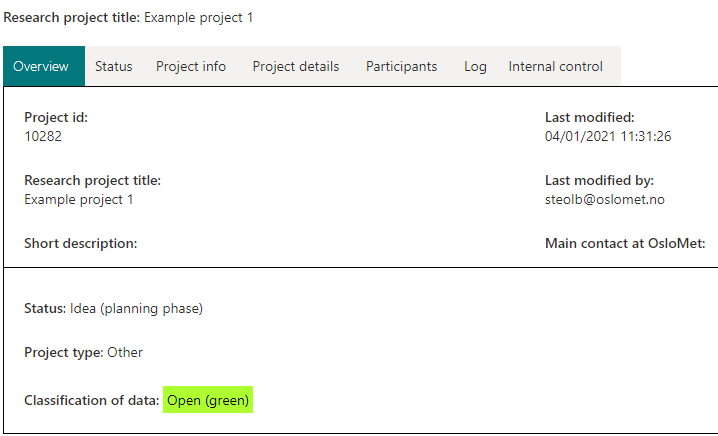
-
Status
Er eit "historisk" prosjekt avslutta, eller søknaden ikkje vart innvilga, så kan det klassifiserast med grøn farge. Då treng dere ikkje å fylle ut fanene som gjeld databehandling og godkjenningar. NB! Dette gjeld berre historiske prosjekt.
Status
Enter the applicable status of the project here. This must be updated over the course of the project.
- Idea (planning phase): Mapping and planning phase.
- Application submitted: You have submitted an application/tender for external funding.
- Active: The funder has granted the project application. The project can start or has started.
- Concluded: The project has concluded. This means that data have been submitted for archiving, and/or data that may no longer be processed have been erased (and confirmation of the erasure sent to the Norwegian Centre for Research Data, NSD).
- Not approved: The project has not been approved. Also applies if it has been rejected. The project has been stopped.
- Internal: Must not be used by researchers, for administrative use only.
Project type
Specify the project type that corresponds most with your project:
- Researcher's project: Research project
- PhD project: Applies if you are a PhD candidate, and the project is in connection with your PhD.
- Master degree project: Student paper at master level where personal data have been processed.
- Bachelor degree project: Student paper at bachelor level, where personal data have been processed.
- Internal and Other: Must not be used by researchers, for administrative use only.
Classification
The type of data processed in the research project and their classification will determine what system can be used for processing and storing data.
- Open (green): Information that can or will be made available to everyone, without access control requirements.
- Restricted (yellow): Information that is not open to everyone. In laws or other regulations, there is no requirement for the information to be open. This is all information that is not classified as open, confidential, or strictly confidential.
- Confidential (red): This is used if it will cause harm to the university, individuals or partners if the information becomes known to unauthorised persons. The information requires strict access control. This could apply to certain strategy documents, health data and other specific categories of personal information,
- Strictly confidential (black): Information that could cause significant harm to public interests, the university, individuals or partners if information becomes known to unauthorised persons. (Not used at OsloMet.)
More information about the classification of data.
REK
Check if the project require approval from the Regional Ethical Committees
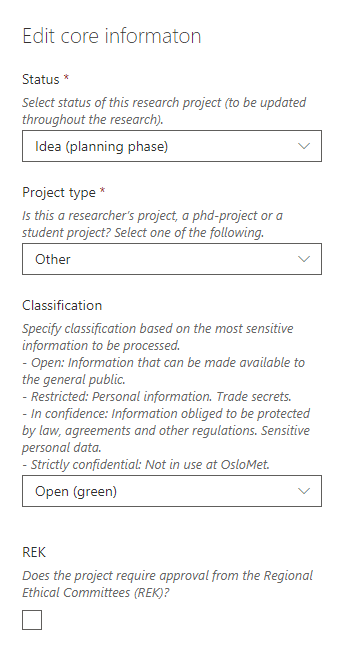
-
Edit project info
- Enter Norwegian and English title and acronym, if the project has it.
- Enter subtitle in Norwegian and English, if the project has it.
- Enter short description and abstract in English and Norwegian. For use i.a. on OsloMet's external website if your project is to be seen there. NB: Do not post information that may be important in a patent process or other sensitive information!
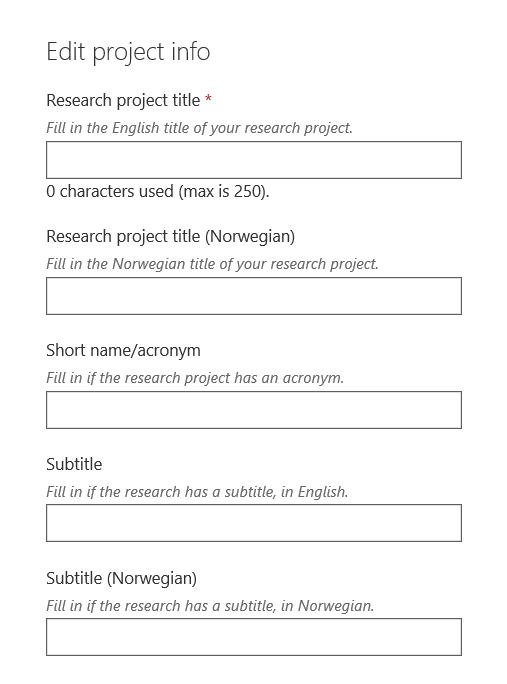
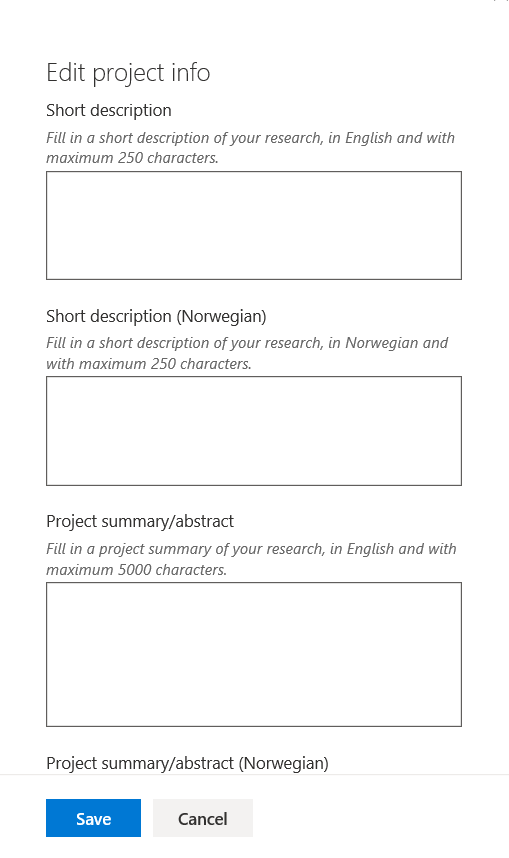
-
Project details / edit core information
- Enter source of funding, program / activity, total budget, OsloMets share, application deadline (if you know this) and countries involved.
- Check if the project is interdisciplinary. The project is defined as interdisciplinary if the project comprises two or more subject areas at level 1 in accordance with the Norwegian Council for Higher Educations division of science disciplines:
- Humanities
- Social sciences
- Mathematics and Science
- Technology
- Medical sciences
- Agriculture and fisheries sciences
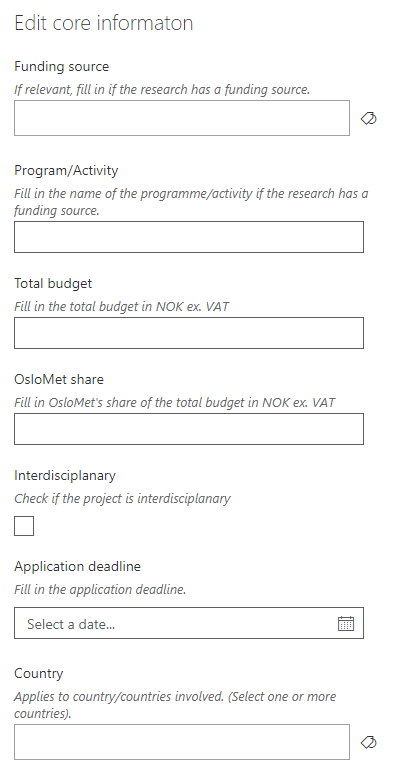
- Enter project start and end and website URL (if available). NB! Do not end URL with / (slash), then it will not be displayed.
- Enter keywords
- Enter SDG Goals and Targets
-
The Sustainable Development Goals (SDG) comprise 17 goals, which all have their own targets. You can find more information about them by following the links below.
Use the drop-down menu you find by clicking the icon to the right of the field, to select the goals that the research project will help to achieve. You can also start writing the number of the SDG, if you know it, and select the alternative that appears.
When you select a target, you must also tick the pertaining goal.
You can find more information about the SDGs here: Sustainable Development Goals
-
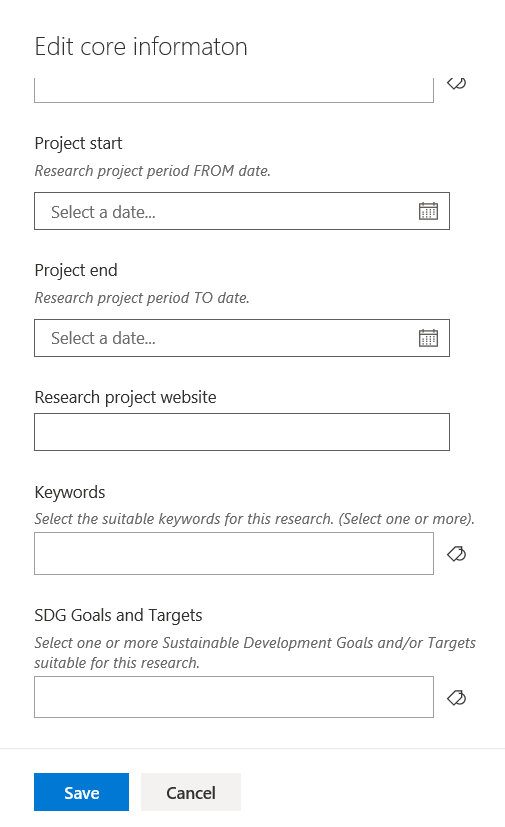
-
Participants
Does the project have an external project owner? Tick here, and enter the name of the organisation that is the project owner.
If OsloMet is the project owner, select which institute/centre the project is affiliated to.
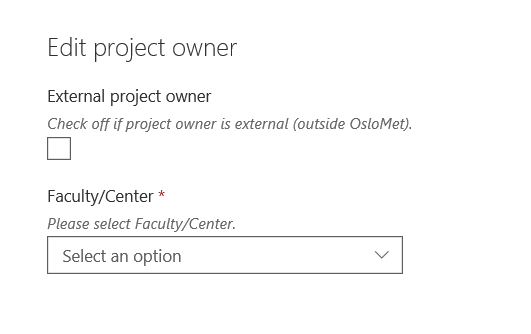
Add main contact at OsloMet
Enter the name or short name of the employee at OsloMet who is to be registered as the main contact. The field below will be filled in automatically. The main contact will also be visible in the Overview tab, and under All projects on the front page. In student projects, the supervisor must be the main contact for the project.
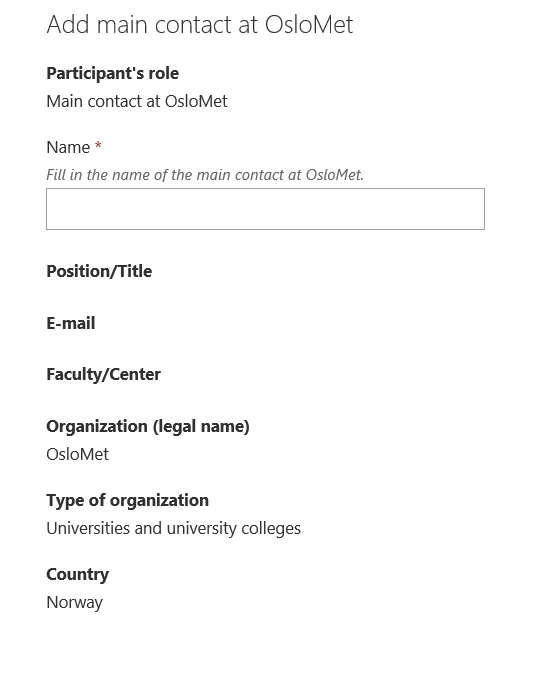
Add external participant
Roles
Enter the person’s function/role in the project. If the person has multiple roles, you tick these roles. Select from the drop-down menu to the right of the field. You can also start writing roles, and get hits from the drop-down menu.
Also enter the name, title, e-mail faculty / center, organization, type of organization and country of external participant.
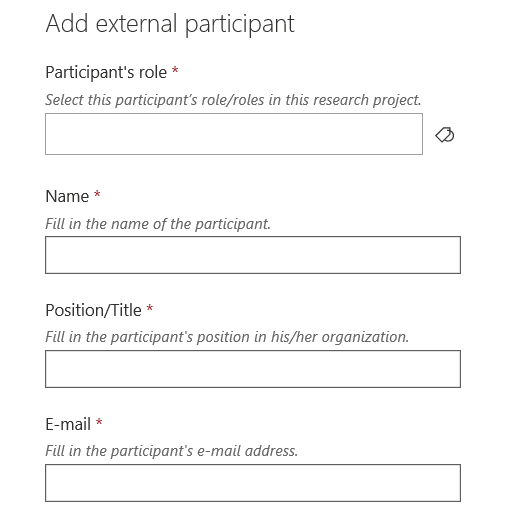
-
Data management
It is critical that research data are processed correctly and in accordance with laws and regulations.
Data that belong to a given institution may be reserved for the institution’s employees, or shared with other researchers under special conditions. There will be examples in a research project where external parties process data. The people who are going to process data must be registered here. There may be several data processors in a research project, and they must be entered in this overview.
Background for approval
There must be grounds for processing in order to process personal data for that purpose. Select one of three alternatives that apply to this research project:
- Consent to processing: Consent (datatilsynet.no)
- Law (legal ground): Necessary to fulfil a contract (datatilsynet.no) or Necessary to fulfil a legal duty (datatilsynet.no)
- Public interest (with legal basis): Necessary in order to carry out a project in the public interest or exercise public authority (datatilsynet.no)
The Data Protection Authority writes the following about grounds for processing on its website (datatilsynet.no): If multiple grounds for processing are appropriate, one set of grounds must be selected per purpose. The organisation also has a duty to inform (datatilsynet.no) the individual about the grounds on which their personal data are being processed. An overview of all the grounds for processing is provided in Article 6 of the General Data Protection Regulation (GDPR) (lovdata.no) (lovdata.no).
Enter:
- name of participant
- name of organization
- function (what the data processor must perform on data that is made available)
Data protection impact assessment (DPIA)
Tick whether a data protection impact assessment (DPIA) is to be carried out.
A DPIA is carried out to secure the data protection of the person registered in a technical solution or a project. This is necessary in the event of a high risk to physical persons’ ‘rights and freedoms’.
You must consider whether a DPIA should be carried out for all processing operations. The data protection official must be consulted when considering whether a DPIA should be carried out, and during the process itself. NSD (Norwegian Centre for Research Data) can help you with this assessment.
Further information: About data protection impact assessment (DPIA)
Conditions
Enter any special conditions that apply to the processing. The complete conditions must be included in the data processor agreement, this field is for the main points only.
NOTE: The conditions are only visible when you click on and go into the individual data processor.
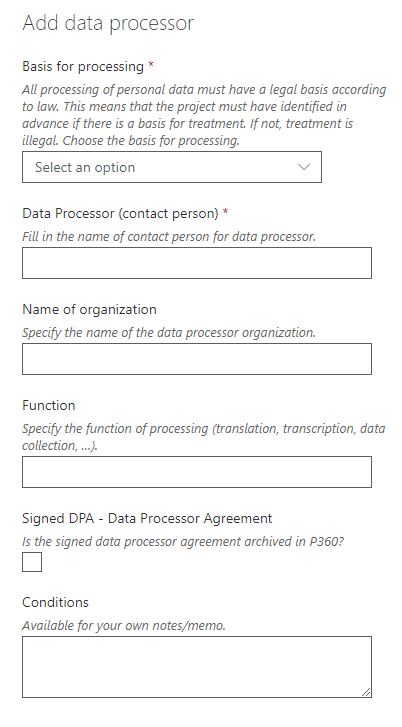
-
Approvals
License agency / Type of approver/advisor
All research projects that process personal data must receive an assessment by or advice from, and, if relevant the approval of, a body before you start processing personal data.
Fill in the relevant body for your research project.
- NSD: Assessment of grounds for processing (general personal data) or advice (‘special categories’).
- The Regional Committees for Medical and Health Research Ethics (REC): Justification assessment (research ethics pages) of health research projects, and dispensation from the duty of confidentiality.
- Statistics Norway: Approval
- Others: Approval or dispensation from the duty of confidentiality.
Add more approvals as necessary.
Date of expiry of approva
Enter the expiry date of the approval.
Application approved
Tick if the application for approval has been granted. Enter the date.
Storage requirements after ordinary end of project
In some cases, approval entails data being stored beyond the project period. If this applies to this project, tick and enter the final date for the storage of data.
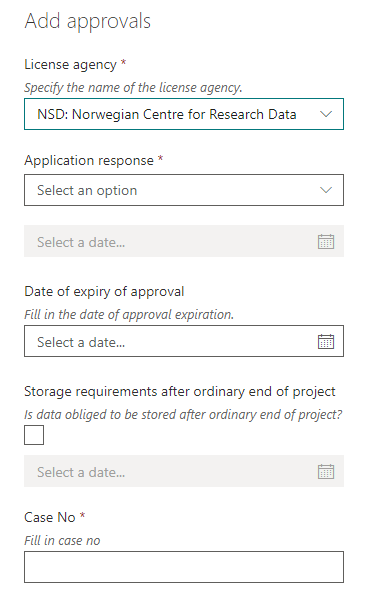
-
Log
Select category
Select the category the change applies to. Fill in the change and then save. Note that some changes may also require you to contact the approval institution.
Information about the different categories:
- Project period: Fill in whether the start and/or end date have changed.
- Also enter the correct date under project information.
- Purpose for processing: If the purpose for processing changes, this must also be registered here.
- Method: It may be expedient at times to change the research method. This must be registered here if it applies to this project.
- Organisation: May apply to changes to project manager, or new partners and project participants joining or leaving the project. Enter the changes here, in addition to adjusting the relevant tabs.
- Other: Other major changes to the project that it is expedient to register in the log.

-
Internal Control
Internal control will be used to log comments to the project from e.g. Data Protection Officer.
